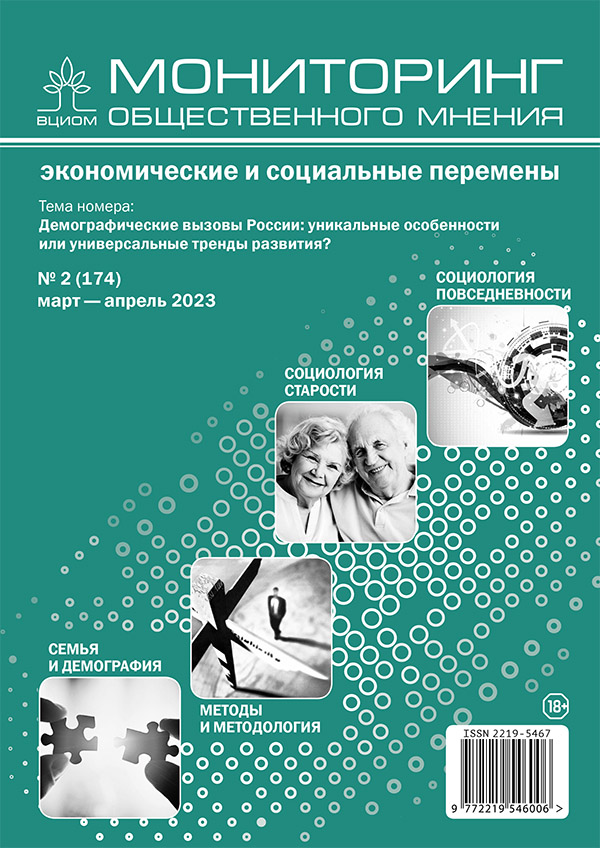Demographic Research in Modern Context: Long-Term Trends and Impact of External Shocks
DOI:
https://doi.org/10.14515/monitoring.2023.2.2412Keywords:
demographics, fertility, mortality, pandemic, demographic outcomes of social and economic shocksAbstract
This editor's introduction to the special issue dedicated to Russia's demographic challenges outlines a range of research issues that are relevant in the current socio-economic context and presents the papers included in the issue. The authors point to methodological difficulties associated with assessing the impact of crises on key demographic processes. The main difficulty lies in separating the effects associated with changes in contextual circumstances, i.e., external shocks and the measures of social, demographic, and economic policies introduced in response to it, and long-term dynamics of indicators, that is, the demographic evolution of a particular society. Basing on the examples of several studies, the authors show the possible differentiation of the short-, medium-, and long-term consequences of various shocks on the demographic, economic, and social development of states. The authors note that the high differentiation of demographic indicators across Russian regions demands studying specific features of the demographic development of the country and its individual regions. Such studies, when immersed in an international discussion, can form a scientific basis for the development and reasonable borrowing of effective solutions in the field of demographic policy.
Acknowledgements. The authors express their gratitude to Konstantin Kazenin for his help and meaningful advice in working on the special issue. Svetlana S. Biryukova gratefully acknowledges support from the Basic Research Program of the HSE University.
References
Вакуленко Е. С., Макарова М. Р., Горский Д. И. Репродуктивные намерения и динамика рождаемости населения разных стран в период пандемии COVID-19: аналитический обзор исследований // Демографическое обозрение. 2022. Т. 9. № 4. С. 138—159. https://doi.org/10.17323/demreview.v9i4.16747.
Vakulenko E. S., Makarova M. R., Gorskiy D. I. (2022) Reproductive Intentions and Fertility Trends in Different Countries during the COVID-19 Pandemic: An Analytical Review of Studies. Demographic Review. Vol. 9. No. 4. P. 138—159. https://doi.org/10.17323/demreview.v9i4.16747. (In Russ.)
Aassve A., Alfani G., Gandolfi F., Le Moglie M. (2021) Epidemics and Trust: The Case of the Spanish Flu. Health economics. Vol. 30. No. 4. P. 840—857. https://doi.org/10.1002/hec.4218.
Cohen A. A., Tillinghast J., Canudas-Romo V. (2010) No Consistent Effects of Prenatal or Neonatal Exposure to Spanish Flu on Late-Life Mortality in 24 Developed Countries. Demographic Research. Vol. 22. Art. 20. P. 579—634. https://doi.org/10.4054%2FDemRes.2010.22.20.
Johnson J., Chaudieu I., Ritchie K., Scali J., Ancelin M.-L., Ryan J. (2020) The Extent to which Childhood Adversity and Recent Stress Influence All-Cause Mortality Risk in Older Adults. Psychoneuroendocrinology. Vol. 111. Art. 104492. https://doi.org/10.1016/j.psyneuen.2019.104492.
Karlsson M., Nilsson T., Pichler S. (2014) The Impact of the 1918 Spanish Flu Epidemic on Economic Performance in Sweden: An Investigation into the Consequences of an Extraordinary Mortality Shock. Journal of Health Economics. Vol. 36. P. 1—19. https://doi.org/10.1016/j.jhealeco.2014.03.005.
Nisén J., Jalovaara M., Rotkirch A., Gissler M. (2022) Fertility Recovery Despite the COVID-19 Pandemic in Finland? Finnish Journal of Social Research. Vol. 15. P. 25—44. https://doi.org/10.51815/fjsr.120361.
Noghani-Behambari H., Noghani F., Tavassoli N. (2020) Early Life Income Shocks and Old-Age Cause-Specific Mortality. Economic Analysis. Vol. 53. No. 2. P. 1—19. URL: https://www.library.ien.bg.ac.rs/index.php/ea/article/view/1285/1098 (accessed: 23.04.2023).
Percoco M. (2016) Health Shocks and Human Capital Accumulation: The Case of Spanish Flu in Italian Regions. Regional Studies. Vol. 50. No. 9. P. 1496—1508. https://doi.org/10.1080/00343404.2015.1039975.
Regidor E., Vallejo F., Granados J. A. T., Viciana-Fernández F. J., de la Fuente L., Barrio G. (2016) Mortality Decrease According to Socioeconomic Groups during the Economic Crisis in Spain: A Cohort Study of 36 Million People. The Lancet. Vol. 388. No. 10060. P. 2642—2652. https://doi.org/10.1016/s0140-6736(16)30446-9.
Sobotka T., Skirbekk V., Philipov D. (2011) Economic Recession and Fertility in the Developed World. Population and Development Review. Vol. 37. No. 2. P. 267—306. https://doi.org/10.1111/j.1728-4457.2011.00411.x.
Sobotka T., Jasilioniene A., Zeman K., Winkler-Dworak M., Brzozowska Z., Galarza A. A., Nemeth L., Jdanov D. (2022) From Bust to Boom? Birth and Fertility Responses to the COVID-19 Pandemic. https://doi.org/10.31235/osf.io/87acb.
Yeung G. Y. C., van den Berg G. J., Lindeboom M., Portrait F. R. M. (2014) The Impact of Early-Life Economic Conditions on Cause-Cpecific Mortality during Adulthood. Journal of Population Economics. Vol. 27. No. 3. P. 895 919. https://doi.org/10.1007/s00148-013-0497-1.
Downloads
Published
How to Cite
Issue
Section
License
Copyright (c) 2023 Monitoring of Public Opinion: Economic and Social Changes Journal (Public Opinion Monitoring) ISSN 2219-5467

This work is licensed under a Creative Commons Attribution-NonCommercial-ShareAlike 4.0 International License.






